The Everglades is a unique ecosystem located in the southern part of Florida. It is home to a diverse range of flora and fauna, including over 350 species of birds.
These birds play a crucial role in the functioning of the ecosystem as they help in seed dispersal, pollination, and controlling insect populations.
Many of these bird species are also migratory, making the Everglades an essential stopover site for their long journeys.
However, the Everglades is threatened by human activities, such as urbanization, pollution, and climate change. This article explores the Everglades’ diverse range of bird species, their behavior, and their role in the ecosystem.
14 Everglades Birds
The Everglades is a vast wetland ecosystem covering most of Florida’s southern tip. It is home to a rich diversity of wildlife, including many species of birds. Some birds are endemic to the region, while others are migratory visitors.
We will introduce you to 14 Everglades birds you should know and tell you some interesting facts about them.
1. Bald Eagle
The majestic Bald Eagle is a bird of prey found in North America and recognized as the national symbol of the United States.
With its distinctive white head, brown body, and striking yellow beak, this sea eagle has two known subspecies that form a species pair with the White-tailed Eagle.
It inhabits much of Canada, Alaska, all states in the US, contiguous area, and Northern Mexico near large bodies of water where they feed mainly on fish.
These birds have an impressive wingspan ranging from 1.8 to 2 meters depending on their size, making them one of nature’s most magnificent creatures.
Scientific classification:
| Kingdom | Animalia |
| Phylum | Chordata |
| Class | Aves |
| Order | Accipitriformes |
| Family | Accipitridae |
| Genus | Haliaeetus |
| Species | H. leucocephalus |
Also Featured In Most Common United States Birds, Birds That Live in Colorado
2. Barred Owl
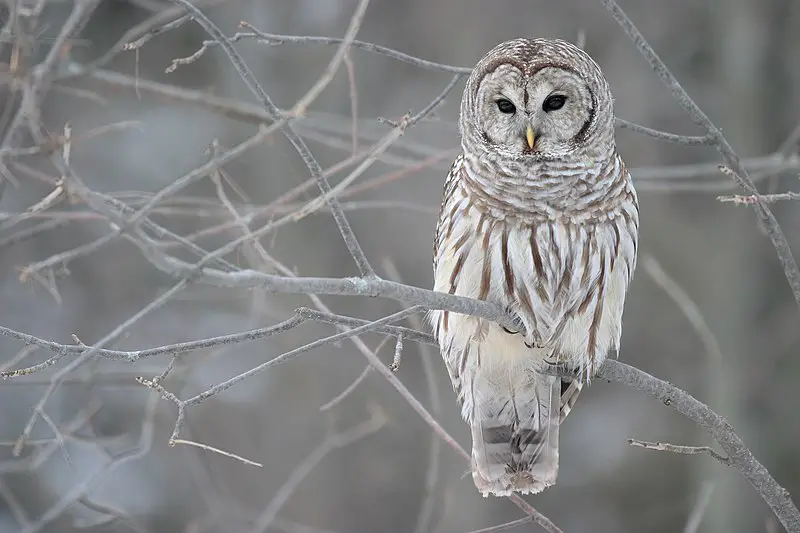
The Barred Owl is a large owl species native to eastern North America. It belongs to the genus Strix, part of the true owl family Strigidae.
These beautiful birds are mainly brown with distinct stripes on their bodies and wings. Its face has dark eyes, a white chin patch, and two black bars across its yellow-brownish beak, giving it an intimidating appearance.
The barred owls have powerful nails for hunting small mammals like mice and voles and other animals such as fish, amphibians, or insects.
They also rely heavily on hearing when looking for prey in low-light conditions.
With their fantastic camouflage abilities, these birds can often remain undetected while observing potential threats from predators – making them highly successful hunters.
Scientific classification:
| Kingdom | Animalia |
| Phylum | Chordata |
| Class | Aves |
| Order | Strigiformes |
| Family | Strigidae |
| Genus | Strix |
| Species | S. varia |
Also Featured In Most Popular Bird Species in North America, Most Common Songs Birds that Live Around You
3. American White Ibis
The American white ibis is a medium-sized bird with white plumage and long legs. It has a bright red-orange downward curved bill and black wing tips, usually only visible in flight.
This species of ibis can be found from Virginia south through most of the coastal New World tropics.
They have been known to inhabit marshes, swamps, ponds, lakeshores, and mangrove forests near water sources where they feed on crustaceans such as crabs and shrimp, among other aquatic animals like insects or snails.
The American white ibis plays an essential role in its ecosystem by helping to control insect populations, which helps maintain balance within these environments.
Scientific classification:
| Kingdom | Animalia |
| Phylum | Chordata |
| Class | Aves |
| Order | Pelecaniformes |
| Family | Threskiornithidae |
| Genus | Eudocimus |
| Species | E. albus |
Also Featured In Top Birds Found in Mexico, Birds You’ll Find in South Texas
4. Little Blue Heron
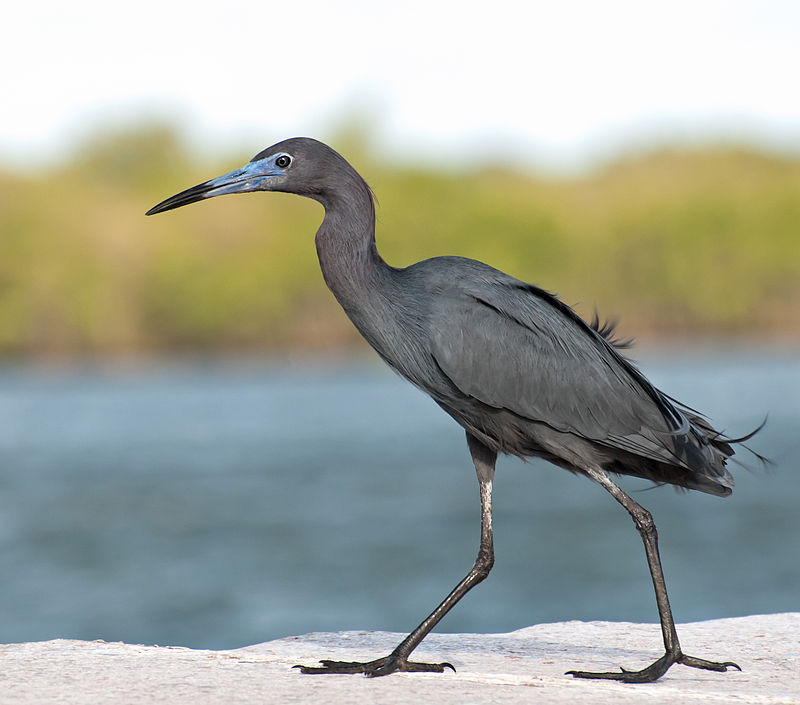
The Little Blue Heron is a small, darkly-colored heron with two-toned bill. Juveniles are entirely white, similar to the Snowy Egret. In breeding season, adults develop unique coloration on their heads and legs.
The bird has an expansive habitat range that covers much of the Americas, from North America down to South America.
They feed primarily in shallow areas like tidal flats or marshes and eat small aquatic animals such as fish, frogs, and crustaceans.
This species can also be found along coastal regions where they gather at night for roosting during winter, when food sources become more scarce due to the migration patterns of its prey animals.
These birds have adapted well over time, allowing them to persist in most habitats throughout their wide range despite environmental changes caused by human activities such as pollution or development projects near wetlands ecosystems, which are essential for this species’ survival.
Scientific classification:
| Kingdom | Animalia |
| Phylum | Chordata |
| Class | Aves |
| Order | Pelecaniformes |
| Family | Ardeidae |
| Genus | Egretta |
| Species | E. caerulea |
Also Featured In Swamps Birds You Should Know, Puerto Vallarta Birds You Should Know
5. Great Blue Heron
The Great Blue Heron is a majestic wading bird found in many parts of North America, Central America, the Caribbean, and even as far away as the Galapagos Islands.
It has an impressive wingspan which can reach up to six feet wide. Its feathers are mainly bluish-gray with brownish streaks on its neck and chest, while its head displays white plumes.
The adult herons can also be identified by their yellow bill and legs.
They live near bodies of water such as lakes, marshes, or rivers, feeding on fish using a spear-like motion with their sharp bills.
An all-white population exists only in South Florida and the Florida Keys, making it unique.
Scientific classification:
| Kingdom | Animalia |
| Phylum | Chordata |
| Class | Aves |
| Order | Pelecaniformes |
| Family | Ardeidae |
| Genus | Ardea |
| Species | A. herodias |
Also Featured In Common Birds in Canada, Birds Commonly Found in New York
6. Roseate Spoonbill
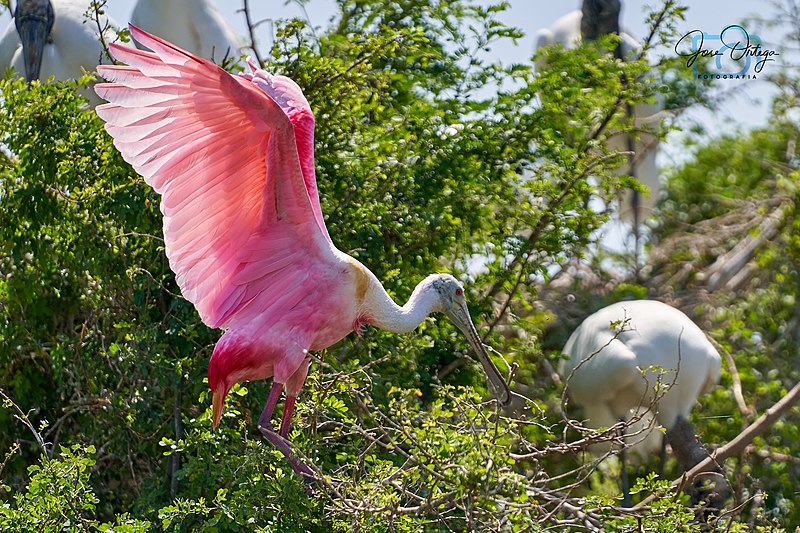
The Roseate Spoonbill is a beautiful and majestic bird in North and South America.
It belongs to the ibis family, Threskiornithidae, and its vibrant pink color comes from canthaxanthin pigment derived from their diet of crustaceans like shrimp.
Sadly, plume hunting almost drove this species close to extinction during the 18th and 19th centuries, but fortunately, it’s coming back due to conservation efforts made by dedicated wildlife organizations.
Its large spoon-like bill helps them filter out food sources such as small fish or frogs from shallow water areas while they wade through mudflats with their long legs looking for something tasty.
With its unique appearance, graceful wingspan, and impressive flight capabilities, the Roseate Spoonbill is an incredibly photogenic animal that will captivate the attention of any viewer lucky enough to witness it in all its glory.
Scientific classification:
| Kingdom | Animalia |
| Phylum | Chordata |
| Class | Aves |
| Order | Pelecaniformes |
| Family | Threskiornithidae |
| Genus | Platalea |
| Species | P. ajaja |
Also Featured In Costa Rica Birds, Famous Paintings Birds
7. Wood Stork
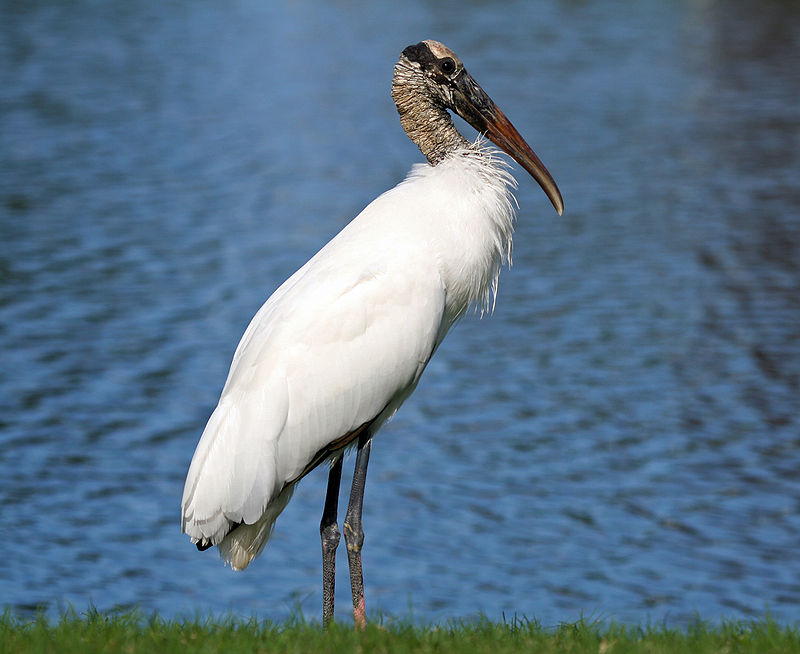
The Wood Stork is a large wading bird found in subtropical and tropical habitats throughout the Americas, including the Caribbean. Its distinctive white head and neck feathers stand out from other storks.
The wood stork has an impressive wingspan of up to 6 feet wide, making it one of the most giant birds in North America.
Although usually seen near water sources such as swamps or wetlands looking for food like fish, crabs, frogs, and even small reptiles, they can sometimes be spotted far away from their natural habitat during migration season.
This species is also one of few breeds annually in North America, with nests typically built on platforms made by humans or animals near water bodies or ponds.
Scientific classification:
| Kingdom | Animalia |
| Phylum | Chordata |
| Class | Aves |
| Order | Ciconiiformes |
| Family | Ciconiidae |
| Genus | Mycteria |
| Species | M. Americana |
Also Featured In: Georgia Birds, Autumn Birds You Should Know
8. Double-Crested Cormorant
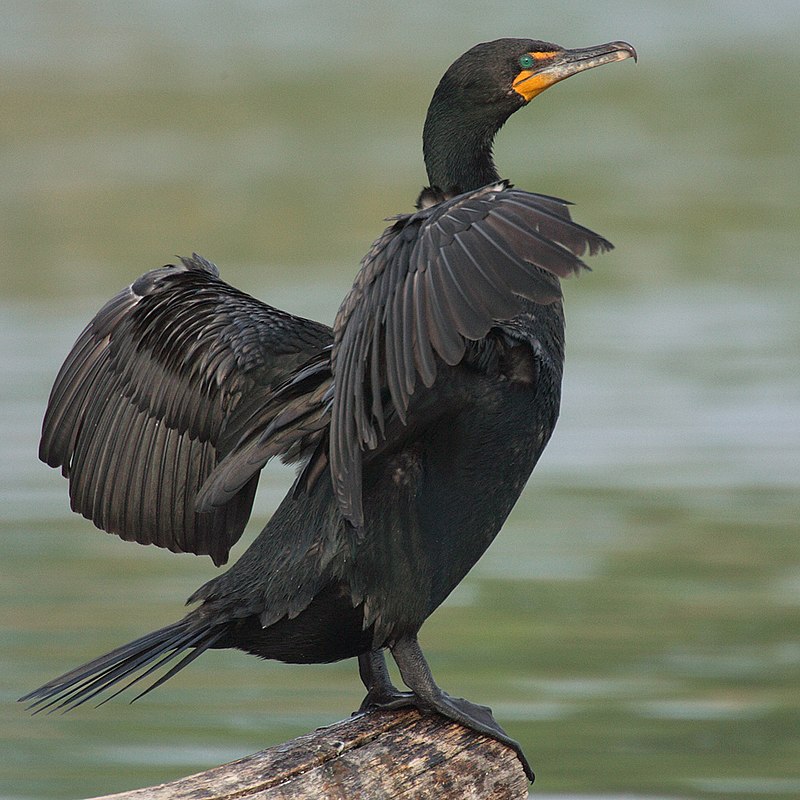
The double-crested cormorant is a majestic bird with an impressive wingspan spanning North America from the Aleutian Islands to Mexico.
Its black plumage stands out against its bright orange-yellow facial skin and some extended patches of white feathers on each side of its throat.
It measures 28 – 35 inches in length and has webbed feet that enable it to swim gracefully through rivers, lakes, and coastal areas.
These birds are known for their voracious appetite for fish, sometimes diving over 100 ft deep into water looking for food.
Despite this reputation, they feed on crustaceans, amphibians, and insects when available.
Cormorants have been part of many cultures throughout history due to their remarkable ability to fly long distances, making them valued messengers or companions during fishing expeditions at sea.
Scientific classification:
| Kingdom | Animalia |
| Phylum | Chordata |
| Class | Aves |
| Order | Suliformes |
| Family | Phalacrocoracidae |
| Genus | Nannopterum |
| Species | N. auritum |
Also Featured In Cormorant Species, Water Birds Live Around Us
9. Seaside Sparrow
The Seaside sparrow is an American bird native to the coastal regions of North America. Its upper parts are brownish with gray on its crown and nape, while its breast has a gray-buff hue featuring dark streaks.
There’s also a white throat, short, pointed shame, and a tiny yellow streak above the eye. The typical lifespan for these birds is 8 to 9 years maximum.
They prefer moist habitats such as marshes, mangroves, and saltwater estuaries, where they feed primarily on seeds and insects found in shallow waters or vegetation near shorelines.
During the breeding season, you can identify them by their singing males who sing from hidden perches during dawn or dusk.
Scientific classification:
| Kingdom | Animalia |
| Phylum | Chordata |
| Class | Aves |
| Order | Passeriformes |
| Family | Passerellidae |
| Genus | Ammospiza |
| Species | A. maritima |
Also Featured In Sparrows Species, Pine Island Birds You Should Know
10. White-Tailed Kite
The White-tailed Kite is a small raptor found in western North America and parts of South America. It was first described by French ornithologist Louis Jean Pierre Vieillot in 1818, with the type locality being Paraguay.
This species belongs to the same family as Old World black-winged kites but is more widespread than its relative.
They are recognized easily due to their distinct white heads and tails, grey wings and backs, yellow eyes and legs.
These birds primarily hunt for rodents such as mice during daylight hours using their exceptional hunting skills, such as hovering midair before diving down on prey or swooping low over grasslands looking for food items on the ground.
In addition, they also feed upon insects, including grasshoppers and locusts, providing them additional nutrition throughout the summer months.
Scientific classification:
| Kingdom | Animalia |
| Phylum | Chordata |
| Class | Aves |
| Order | Accipitriformes |
| Family | Accipitridae |
| Genus | Elanus |
| Species | E. leucurus |
Also Featured In Common Californian Birds, Common Southern Californian Birds
11. Snail Kite
The Snail Kite is a medium-sized bird of prey from the Accipitridae family, including eagles, hawks, and Old World vultures.
Its relative, the Slender-billed Kite, was once part of this family but now belongs to Helicolestes.
The Snail Kite measures around 36 to 48 cm long, with males slightly smaller than females.
They can be identified by their yellow eyes, grey wings, and reddish-brown head feathers, and their hooked bill used for catching food such as snails – hence its name.
These birds are mainly found near rivers or wetlands in tropical climates, feeding on apple snail shells filled with soft fleshy parts.
This species is endangered due to habitat destruction caused by human development, so conservation efforts must be made if we want these beautiful creatures around for many more years.
Scientific classification:
| Kingdom | Animalia |
| Phylum | Chordata |
| Class | Aves |
| Order | Accipitriformes |
| Family | Accipitridae |
| Genus | Rostrhamus Lesson, 1830 |
| Species | R. sociabilis |
Also Featured In: Florida Birds, Wetlands Birds You Should Know
12. American Purple Gallinule
The American purple gallinule is a stunning bird in North and South America. This species belongs to the order Gruiformes, which contains cranes, rails, and crakes.
The family Rallidae classifies it as a rare species, with its scientific name being Porphyrio martinica.
It is also known locally as the yellow-legged gallinule due to its striking plumage of greenish-blue feathers on its wings, back, tail, bright red legs, and bill.
Its environment includes freshwater marshes, swamps, or paddy fields, where these birds feed primarily on plants like water lilies or small invertebrates such as insects or mollusks.
These beautiful creatures are threatened by habitat destruction, especially for agricultural purposes, but conservation efforts are helping them survive despite this threat.
Scientific classification:
| Kingdom | Animalia |
| Phylum | Chordata |
| Class | Aves |
| Order | Gruiformes |
| Family | Rallidae |
| Genus | Porphyrio |
| Species | P. martinicus |
Also Featured In Blue Birds, You’ll Found Around Us, Magenta Birds You Didn’t Know
13. Anhinga
The Anhinga is a water bird found in the warmer parts of the Americas. It is sometimes called the snakebird, American darter, or water turkey.
The bird’s name comes from the Brazilian Tupi language and means “devil bird” or “snake bird.” When swimming, only the Anhinga’s neck appears above water, giving the appearance of a ready-to-strike snake.
It is a skilled swimmer and hunter, using its sharp beak to catch fish underwater. The Anhinga is easily recognizable by its long neck, sharp beak, and distinctive black and white feather coloring.
Its ability to dry its wings quickly after diving is unique among water birds, as it lacks the natural oils that make feathers waterproof.
The Anhinga is an essential ecosystem member, helping control fish populations and serving as prey for larger predators.
Scientific classification:
| Kingdom | Animalia |
| Phylum | Chordata |
| Class | Aves |
| Order | Suliformes |
| Family | Anhingidae |
| Genus | Anhinga |
| Species | A. Anhinga |
Also Featured In: Birds that Live around Central Florida, Birds that Live around Southwest Florida
14. Cape Sable Seaside Sparrow
The Cape Sable seaside sparrow is a small bird native to southern Florida. It is a subspecies of the seaside sparrow and is only found in this region.
This particular bird is considered endangered under the Endangered Species Act, meaning it is at risk of extinction.
The Cape Sable seaside sparrow is around 13 to 14 centimeters long and has a distinct dark olive-gray back. Its tail and wings are also a similar color.
This bird’s small size and unique coloring make it a fascinating species for birdwatchers and ornithologists to study.
As a resident of the endangered list, conservation efforts are in place to help protect and preserve its habitat and prevent its extinction.
Scientific classification:
| Kingdom | Animalia |
| Phylum | Chordata |
| Class | Aves |
| Order | Passeriformes |
| Family | Passerellidae |
| Genus | Ammospiza |
| Species | A. maritima |
| Subspecies | A. m. mirabilis |
Conclusion
The Everglades ecosystem boasts diverse avian inhabitants, each playing a vital role in maintaining the delicate balance of this unique environment.
From the majestic Great Blue Heron to the colorful Roseate Spoonbill, these birds contribute to the vitality and resilience of the Everglades ecosystem.
However, they face ongoing challenges, such as habitat loss and climate change, threatening their existence. Conservation efforts must be prioritized to safeguard these feathered residents and preserve the rich biodiversity of the Everglades for future generations to appreciate.